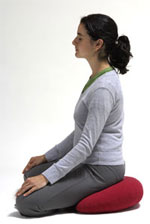Although listening to the audio guidance while carrying out the meditation, you may find that reading through this will also help enormously.
Step 1 – Settling
1. Settle into a comfortable position, either lying on a mat or rug, or sitting upright on a chair, or on a cushion (upright
2. If you do have a cushion, it’s helpful if your knees actually touch the floor – although this may not happen at the beginning. DON’T SWEAT IT.
Just experiment – find a posture that is comfortable for you.

3. If lying down, allow your legs to be uncrossed, with your feet falling away from each other, arms lying alongside
4. Just experiment – find a posture that is comfortable
Step 2 – Bringing Awareness to the body
5. Bring your awareness to the physical sensations by focusing your attention on the sensations of touch in the body where it is in contact with the floor and what ever you are sitting or lying on.
6. Spend a few moments exploring these sensations.
7. Now focus your attention on your feet , starting with the toes, expand the spotlight of attention so its takes in the souls of your feet, the heels and the top of the feet, until you are attending to any and all the physical sensations you become aware of both in the feet – moment by moment.
8. Spend a few moments, just focusing on the sensations in the feet. If there are no sensations then simply register a blank – this is fine. You are not trying to make a sensation happen you are simply exploring what is already there.
9. Now expand your attention to take in the rest of both legs for a few moments, then the torso (from the pelvis and hips up to the shoulders); then the left arm; then the right arm; then the neck and head
10. Spend a minute of two resting in awareness of the whole body. See if its possible to allow your body and its sensations to be just as you find them.
11. Explore how it is to let go of the tendency to want things to be a certain way. Even one brief moment of seeing how things are – without wanting to change anything – can be profoundly nourishing.

Step 3 – Focusing on the sensations of Breathing
12. Now bring your awareness to the breath as it moves in and out of the body at the abdomen. Notice the changing patterns of physical sensations in this region of the body as the breath moves in and out.
It may help to place your hand there for a few breaths, and feel the abdomen rising and falling.
13. You may notice mild sensations of stretching as the abdomen gently rises with each in-breath and different sensations as the abdomen falls with each out-breath,
14. As best you can, follow closely your attention, so you notice the changing physical sensations for the full duration of each in breath and the full duration of each out breath, perhaps noticing the slight pauses between one in-breath and the following out-breath and between one out-breath and the following in-breath.
15. There is no need to try and control your breathing in any way at all – simply let the breath breathe itself.

Step 4 – (IMPORTANT) Dealing with mind wandering
Sooner or later (usually sooner), your attention will wander away from the breath. You may find thoughts or images, plans or day dream coming up.
Such mind wandering is not a mistake.
It is simply WHAT MINDS DO.
When you notice that your awareness is no longer on the breath, you might CONGRATULATE yourself. You have already ‘woken up’ enough to know it, and are once more aware of your experience in this moment.
Simply acknowledge where your mind has wandered to. Then gently escort your attention back to the sensations in your abdomen.
The mind is likely to wander OVER and OVER again…. so each time, remember that the aim is simply to note where the mind has been, then gently escort your attention back to the breath.
This can be VERY DIFFICULT, as you may find it frustrating that the mind seems so disobedient! Such frustration can create a lot of extra noise in the mind, so no matter how many times your mind wanders, allow yourself on each occasion (without limit) to cultivate compassion for your mind as you bring it back to where you had intended it to be.
See if its possible to view the repeated wanderings of the mind as opportunities to nurture greater patience with yourself.
In time you may discover that this quality of kindness towards the wandering mind brings a sense of compassion towards other aspects of your experience – that the wandering mind has been a great ally in your mindfulness practice and not the enemy you supposed it to be.
Continue with the mindful mediation for around 8 minutes or longer if you wish , perhaps reminding yourself from time to time that the intention is simply to be aware of your experience in each moment.
As best you can, use the sensations in your body and breath as anchors to gently reconnect with the here and now each time you notice that your mind has wandered and is no longer in touch with where you intended it to be.

